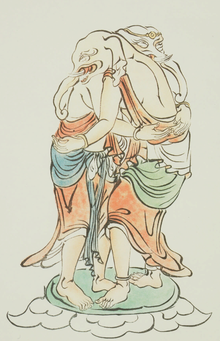| Kangiten (Nandikeshvara) | |
|---|---|
| |
 Dual-bodied (Sōshin) Kangiten | |
| Other names | Shōten / Shōden (聖天) Shōten- / Shōden-sama (聖天様 / 聖天さま) |
| Japanese | 歓喜天 (shinjitai) 歡喜天 (kyūjitai) |
| Affiliation | Deva Vairochana Buddha Eleven-Headed Avalokiteshvara Amritakundalin Sanbō Kōjin |
| Abode | Mount Kailash (Keira-sen) |
| Mantra | Oṃ hrīḥ gaḥ huṃ svāhā (On kiri(ku) gyaku un sowaka) |
| Weapon | axe, trident |
| Symbols | kangidan (modak), daikon, kinchaku |
| Gender | Male |
| Genealogy | |
| Parents |
|
| Siblings | Senayaka (brother, later reincarnated as wife; incarnation of Avalokiteshvara) Skanda (brother) Kigeiten (sister) |
| Consort | Senayaka |
| Equivalents | |
| Hindu | Ganesha |
Kangiten or Kankiten (Japanese: 歓喜天, "god of bliss";[1] Sanskrit (IAST): Nandikeśvara), also known as Binayaka (毘那夜迦; Skt. Vināyaka), Ganabachi (誐那鉢底, alternatively Ganahachi or Ganahattei; Skt. Gaṇapati), or more commonly, Shōten or Shōden (聖天, lit. "sacred god"[2] or "noble god"[3]), is a deva (ten) venerated mainly in the Shingon and Tendai schools of Japanese Buddhism who is the Buddhist equivalent of the Hindu god Ganesha.[2][4][5][6]
Although Kangiten (Shōten) and Ganesha share a common origin and a number of traits, there are also some marked differences between the two. For instance, the Buddhist Vinayaka was (at least at first) negatively portrayed as the creator of obstacles and the leader of a class of malignant demons who obstructed Buddhist practice called vinayakas, though later tradition made an attempt to distinguish between the vinayakas and their lord, who became seen as a manifestation of the bodhisattva Avalokiteshvara (Kannon in Japanese) and/or the buddha Vairochana.
Kangiten enjoys both a positive and negative reception in Japan. On the one hand, he is popularly revered as an extremely efficacious god who grants whatever is asked of him without fail, including impossible wishes. He is also said to watch over those who have a karmic connection with him from the moment of their conception, serving as their invisible companion throughout their lives. On the other hand, he is considered to be still bound by base passions and desires (kleshas) and thus is sometimes also regarded as a rather volatile, demanding god who is quick to punish those who have offended him.
Unlike his Hindu counterpart, whose image is prominently displayed in public, Kangiten is considered too sacred to be seen: images of the deity in temples are kept hidden from view, rituals centered on him are performed by qualified monks out of public sight, and lay devotees are discouraged from venerating iconographic depictions of the god at home.
While he is sometimes depicted as an elephant-headed single male deity like Ganesha, he is more commonly portrayed as a male-female couple (both with elephant heads) standing in an embrace in an iconographic depiction known as the Dual(-bodied) Kangiten (双身歓喜天, Sōshin Kangiten) or the Embracing Kangiten.
- ^ Buhnemann (2006), pp. 19–20.
- ^ a b Hanan (2003), pp. 245–6.
- ^ Krishan (1999), p. 163.
- ^ Frédéric (2002), p. 470.
- ^ "歡喜天 (Gaṇeśa)". Digital Dictionary of Buddhism. Retrieved 2021-06-02.
- ^ Pandey, Rajyashree (22 February 2007). "Performing the body in medieval Japanese narratives: Izumi Shikibu in Shasekishū". Japan Forum. 19 (1): 119. doi:10.1080/09555800601127361. S2CID 143714073.